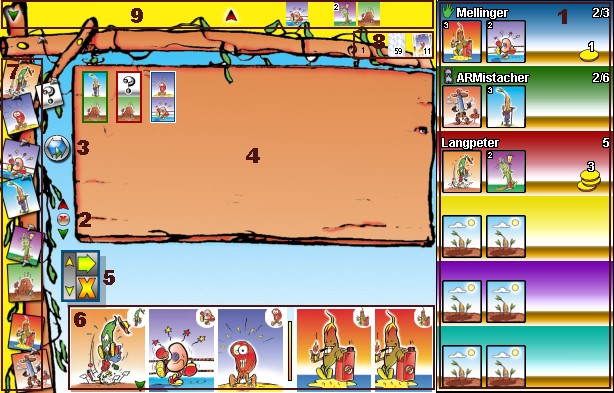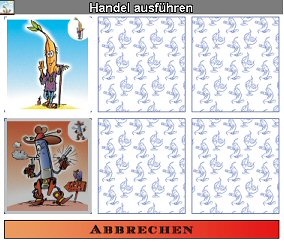Bohnanza
Preparazione del gioco
Con /join possono giocare da 3 a 5 giocatori. Con /start inizia la partita. In alternativea si usa il Tool di Gioco.
Il gioco
Bohnanza è un divertente gioco di carte nel quale bisogna piantare e raccogliere, per venderli, vari tipi di fagioli. Il gioco si basa essentials sul commercio e lo scambio dei fagioli. E' possibile effettuare scambi di qualsiasi tipo. E anche essere un po' cattivi... Perché no?
Tavolo di gioco

- Stato dei giocatori
- Selezione dei Fagioli
- Pulsante della fase
- Mercato dei fagioli
- Finestra delle offers
- Carte in mano | Carte scambiate (linea di separazione mobile)
- Catalogo dei fagioli
- Stato del gioco (annuncio delle trattative - numero di carte restanti nel mazzo - numero di carte scartate)
- Area richies

- A - Indicatore del giocatore attivo
- B - Nome del giocatore
- C - Carte in mano / Fagioli scambiati (che devono ancora essere piantati)
- D - Campo di Fagioli
- E - Numero di Monete
Svolgimento
La regola più importante di Bohnanza è che non bisogna per nessun motivo scambiare l'ordine delle proprie carte! E' obbligatorio giocare sempre la carta più a sinistra nella propria mano. Le nuove carte vengono aggiunte a destra.
Ogni giocatore comincia con cinque carte in mano e due campi vuoti nei quali può piantare dei fagioli. Non appena si guadagnano tre monete è possibile acquistare un terzo campo.
Il gioco si svolge in quattro fasi.
1 - Giocare carte dalla propria mano
2 - La fase principale, durante la quale avvengono le trattative e gli scambi.
3 - Coltivare i fagioli piantati
4 - Pescare carte
Le fasi 1,2, e 4 passano molto velocemente.
Fase 1

Il giocatore attivo deve giocare la sua prima carta (quella più a sinistra), cioè piantarla in uno dei suoi campi.

In seguito può piantare nello stesso modo il fagiolo successivo, sempre seguendo l'ordine delle carte che si hanno in mano. Se non lo vule fare, clicca sul pulsante "Passa". Si passa ora alla fase 2.
Regole per piantare fagioli:
- In ciascun campo è possibile coltivare unicamente fagili dello stewards tipo.
- Il numero di fagioli in un campo non è limitato.
- Se non è possibile piantare un fagiolo su un campo con lo stesso tipo oppure in un campo vuoto, bisogna raccogliere i fagioli di uno dei campi per fare posto e poter piantare.
Raccogliere i fagioli
Regole da tener presente per il raccolto:
- S does not i campi contengono più fagiolo, si può raccogliere da qualsiasi campo.
- S and campo contien in solo fagiolo e l'altro/i contengono più fagiolo, si deve raccogliere il campo che contiene più fagiolo.
- S does not i campi contengono in solo fagiolo, è possibile raccogliere da qualsiasi campo.
- Si può raccogliere anche da campi che non fanno guadagnare nessuna moneta.
- I fagioli di un campo devono sempre essere raccolti per intero.
- Un numero di fagioli del tipo raccolto, uguale al numero di monete guadagnate, viene ritirato dal gioco. Se per esempio, si raccolgono quattro soybean, due di questi vengono ritirati dal gioco.
Il numero di monete che fa guadagnare il raccolto dipende dal tipo di fagiolo che era piantato.

Ciascun fagiolo ha un fagiolometro, visualizzato in una finestra di aiuto che compare rimanendo sulla carta. La finestra indica il numero totale di quella specie di fagiolo esistente in gioco (nell'esempio, 12 soybean), il nome della specie e il fagiolometro per il raccolto. Il fagiolometro nell'illustrazione indica che per la raccolta di 2/4/6/7 Soybean si ricevono 1/2/3/4 monete (Per esempio se si raccolgono 6 Soybean si ottengono 3 monete). Più un fagiolo è comune nel gioco e più se ne devono raccogliere per ottenere un buon guadagno.
Fase 2

La fase 2 è il cuore del gioco.Due carte vengono pescate dal mazzo girate e disposte sul tavolo. Il giocatore attivo può piantare direttamente questi fagioli, oppure scambiarli con gli altri giocatori. Se vuole piantarli, clicca sul pulsante phase. Ora può piantare i fagioli appena pescati nei suoi campi rispettando le regole elencate in precedenza.
Attenzione! Nella fase 2 nessuna carta può essere aggiunta alla propria mano. Tutte le carte acquisite durante questa fase devono essere immediatamente piantate alla fine della fase 2.
Nella maggior parte dei casi i giocatori non vorranno piantare i due fagioli perché questo li costringerebbe a esaurire dei campi che non farebbero guadagnare nessuna moneta. Si cerca quindi di sbarazzarsi dei fagioli pescati. Per fare questo i giocatori fanno delle proposte o aspettano le offerte degli altri giocatori. Si possono fare scambi solo con il giocatore attivo. Il giocatore attivo può fare offerte o rispondere quelle degli altri giocatori.
Fare delle proposte

Per scambiare dei fagioli, si procede in questo modo:
si clicca sui fagioli che si offrire tra quelli in mano e quelli appena pescati. La specie scelta appare quindi nella finestra delle offeringte in alto (nell'esempio il fire bean). Per i fagioli che vorremmo ricevere, clicchiamo sulle carte nella colonna di sinistra (il catalogo). I fagioli appaiono quindi nella finestra delle offeringte in basso (nell'esempio i sour bean). Per fare un'offerta nel mercato, si clicca sulla freccia nella finestra delle offeringte. L'offerta quindi compare - con una cornice del colore del giocatore - nel mercato. Se si vuole annullare la proposta, basta cliccare sulla X.
Nella finestra delle offeringte, fino a che non si invia l'offerta, è possibile cambiare i fagioli. Si clicca sui fagioli da aggiungere, come spiegato precedentemente, e si eliminano quelli già proposti semplicemente cliccandoli.
Accettare le proposte

Tutte le offerte sono indicate nel mercato. I fagioli che vorremmo offrire sono visualizzati nella parte superior della finestra, i fagioli che vorremmo ricevere nella parte inferiore.
Se il giocatore attivo vuole accettare l'offerta di un altro giocatore, clicca semplicemente su quell'offerta.

Si apre quindi una finestra di scambio per i due giocatori e ciascuno sposta i fagioli che offre sui fagioli in questione, evidenziati in grigio nella linea in basso. Quando i fagioli sono stati spostati correttamente le immagini non sono più grigiate. Una volta che entrambi i giocatori sono soddisfatti dello scambio, la finestra di scambio scompare e le carte scambiate vengono visualizzate a destra della mano del giocatore.
Se un giocatore è interessato all'offerta del giocatore attivo, la seleziona. L'offerta viene visualizzata nuovamente nel colore del giocatore che ha manifestato l'interest, per indicare al giocatore attivo chi è interessato all'offerta. Se più giocatori sono interessati, il giocatore attivo può scegliere l'offerta che preferisce. Una volta scelta l'offerta si apre la finestra di scambio per i de giocatori in questione.
Ciccando il pulsante di fase, il giocatore attivo può terminare la fase 2 in qualsiasi momento. In seguito nessuna può avere luogo.
Fase 3

Quando il giocatore attivo termina la fase 2, tutti i fagioliiti acquis devono essere piantati da tutti i giocatori nei propri campi. Si applicano le regole della fase 1.
Fase 4
Il giocatore attivo a questo punto pesca tre carte, che si piazzano a destra delle carte già in mano.
Il round termina e si passa al giocatore seguente.
Fine del gioco
Il gioco finisce quando le carte si esauriscono per la terza volta. Se questo accade durante la fase 2, gli scambi possono ancora avvenire. Se l'ultima carta viene pescata nella fase 4, il gioco termina immediatamente. Tutti i fagioli piantati vegono raccoli. Il giocatore che a questo punto possiede più monete ha vinto. In caso di pareggio vince il giocatore, tra quelli con più monete, con più carte in mano.
Dettagli Supplementari per la fase di scambio
- Per gli scambi il giocatore attivo può usare i due fagioli pescati nella fase 2 e quelli della sua mano.
- Fagioli già scambiati None possono essere scambiati nuovamente.
- Si possono anche regalare delle carte. Basta lasciare vuota la parte inferiore della finestra delle offeringte.
- Si può ritirare l'offerta in qualsiasi momento cliccando col tasto destro sulla proposta. Il giocatore attivo può eliminare tutte le offerte nel mercato.
- Il modo più semplice per fare le offeringte è usare il tasto sinistro del mouse:
clic sinistro su una carta nella mano = offrire la carta
clic sinistro sulle carte visualizzate a destra(catalogo) = carta desiderata.
IN ALTERNATIVA:
Clic destro su una carta nella mano = carta desiderata Clic sinistro su una carta nella mano = carta offeringta Le carte del catalogo (a destra) funzionano ugualmente con la logica inversa.

Si possono anche fare offerte libere, per esempio "Offo un Red Bean, cosa mi date in cambio?" Pe far questo si utilizza la carta punto interrogativo a sinistra.

Per avvertire il giocatore attivo che le offeringte attuali non ci interessano o che non vogliamo scambiare tutto, possiamo cliccare nella fase 2 sul pulsante di fase. La freccia blu presenta un contarssegno di 'nessuno scambio'.

Nella sezione di stato dei giocatori appare un segno, che indica che non siamo più interessati ad alcuno scambio. Se viene fatta un'offerta interesting è comunque possibile annullare il contrassegno "Stop" cliccando una seconda volta sul pulsante di fase.

Se un giocatore non ha cliccato nella finestra di gioco da più di dieci secondi, appare una clessidra di fianco al nome del giocatore. Scompare non appena il giocatore clicca da qualche parte. Questo permette al giocatore attivo di sapere se un altro giocatore sta componendo un offeringta che potrebbe influenzare la trattativa. Se così fosse il giocatore attivo può attendere prima di finire la sua fase di scambio.
Offerta e domanda

Per indicare agli altri giocatori quali fagioli vorremmo offrire o ricevere è possibile usare l'indicatore di commercio. E' sufficient trascinare la freccia verde su un fagiolo della propria mano o del catalogo per indicare quale fagiolo vorremmo ricevere. Similmente basta trascinare la freccia rossa sul fagiolo desiderato per indicare quale vorremmo offrire. Per annullare le freccie cliccare la piccola x sulla freccia appropriata.
I fagioli scelti vengono visualizzati sopra al mercato dei fagioli perché siano visibili da tutti: nella parte destra, i tipi che vorremmo offrire e quelli desiderati dagli altri giocatori; nella parte sinistra quelli che vorremmo ricevere e quelli che gli altri giocatori vorrebbero offrire. E' quindi possibile farsi un'idea chiara dei fagioli richiesti e offerti così da poter fare le offeringte di conseguenza.
Consigli tattici
- Nella fase di scambio è essential fare attenzione all prime carte della propria mano. Se non corrispondono ai tipi di fagioli già piantati, bisogna cercare di scambiarli in tempo, prima di essere obbligati a piantarli.
- Non scambiare fagioli o non accettare i regali può avere gravi conseguenze per gli altri giocatori... ;-)
- Bisogna sempre fare attenzione a quale fagiolo si utilizza negli scambi. Di solito è meglio usare i primi nella propria mano, ma talvolta è più interesting prendere i fagioli più lontani.
opzioni
hiddenmoney
Viene nascosto agli altri giocatori il numero di monete possedute

